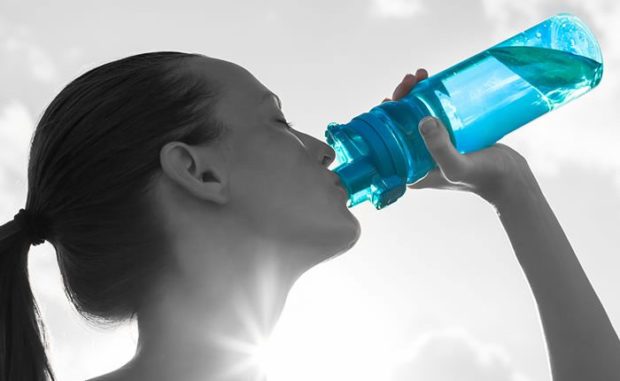Drinking water is an important part of developing a healthy lifestyle, no matter the time of the year. Most people make staying hydrated a habit during the hot months of summer. After all, that is when they’re outside and are sweating more than normal. But staying hydrated in the fall and winter is just as important. Even if you’re as thirsty or sweating as much as you do in the summer, it’s still easy to become dehydrated in cooler weather.

Reasons to drink up in the cooler months
Not drinking enough water in fall and winter can actually have some severe consequences. Many don’t realize that the dry air of cooler weather can dehydrate you. Dehydration can lead to fatigue and sluggish. Dehydration can also lead to you being more susceptible to germs. And since germs spread more easily in cooler weather, you’re more likely to catch a cold or the flu if you’re not staying hydrated. If you want to avoid getting sick this fall or winter, keep drinking water!
Cool, dry air can also cause your skin to dry out and chap. Staying hydrated can help keep your skin healthier. When you drink water, there is less of a chance of your skin becoming dry and flaking. You can also help prevent dry skin in the winter by using a humidifier within your home and using a moisturizer after showers.
Another reason to continue to stay hydrated throughout the cooler months is that it can help make you feel warmer. Your body needs fluids to help maintain a healthy temperature in both the summer and winter. When you’re dehydrated in the fall or winter, your core temperature begins to drop. And when it’s cold outside, the last thing you want is to also be cold internally. Drinking water can help keep you more comfortable when you have to step out of the house.
Speaking of cold weather — most people are less likely to exercise once the weather starts changing because they’d rather be in their nice, warm house. This means that they’re less active and are more likely to gain weight. Drinking enough water can actually help you maintain your current weight despite not being active. When your body is properly hydrated, it is more likely to be able to break down unwanted fat and keep your digestive system functioning properly.
And, finally, you should also stay hydrated because it is just as easy to dehydrate in the cooler months as it is to dehydrate in the hotter months. But it is harder to tell when you’re dehydrated in the cooler months. In the summer months, you know to drink more water whenever you’re sweating profusely. In the cooler months, you’re less likely to notice when you’re sweating because it is quickly absorbed by clothing and because you’re less likely to feel thirsty. But just because you don’t feel like you need to drink water doesn’t mean you shouldn’t.
How much you should drink in the cooler months
Even if you don’t feel as thirsty during fall or winter doesn’t mean you should drink less water. You need to keep drinking the same amount of water that you did during the summer. The amount of water an individual will need to drink depends on various factors, such as gender, age, and health.
Generally, it is recommended for most people to drink between 8 and 10 cups of water a day. People that are physically active or women that are breastfeeding may need to drink up to 12 cups a day. If you need help determining what is the right amount of water for you, consult a doctor.
Ways to stay hydrated in the cooler months
Ways to stay hydrated in the cooler months is no different than the hotter months. If you already are drinking the right amount of water per day, keep up your current routine! But if you aren’t drinking enough water but want to get in the habit, here are some tips on getting started.
The best way to stay hydrated is by developing a routine. Drink water throughout the day, especially when you first wake up or before you eat a meal. Some people like to carry around a water bottle so that they can sip on water throughout the day. Consider using a reusable water bottle because plastic water bottles are bad for the environment. If you live in an area with questionable water quality, check out this filtered water bottle guide to find a reusable water bottle that will help keep you healthy.
Many people have trouble getting into the habit of routinely drinking water. Tracking your water in a journal or an app is a good way to remind yourself of how much water you’re drinking in a day. If you routinely find yourself missing your recommended amount, you’ll be able to consciously drink more cups of water throughout the day. Once you develop a routine, you’ll be more likely to drink enough water without even thinking about it.
If you’re among those that find the taste of water plain or disgusting, consider adding some fruit juice to your water. This adds flavor without adding sugar. Citrus flavors, such as lemon or lime, are a popular choice. Simply cut the fruit into wedges and squeeze the juice in. For those that prefer sweeter flavors, strawberries or raspberries are popular choices. You can still cut and squeeze these fruits or you can add them whole to your water. The longer the fruit sits in the water, the stronger the flavors will be.
The cooler months are also a good time to enjoy broths and soups with high water content. Foods that have high water content count towards your daily intake.
Final thoughts
It’s time to put your swimsuits and beach umbrellas away, but don’t pack up your water bottle! Cooler weather doesn’t mean you should stop drinking water. If you want to remain healthy, keep filling up that water bottle every time you leave the house.



